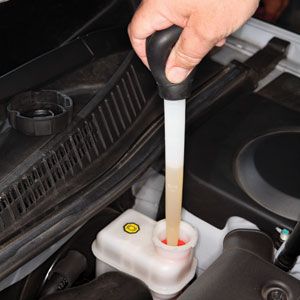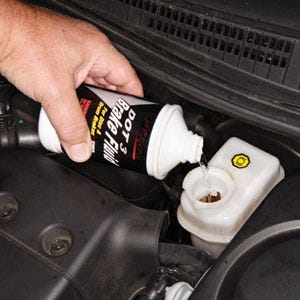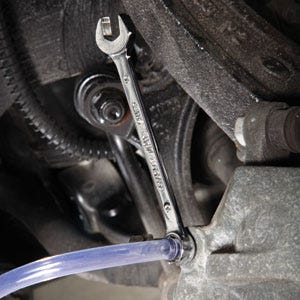Where Can I Go to Get My Brakes Bled
Non even new brake pads tin can save you from the dreaded soft brake pedal. Maybe you noticed that you nonetheless have to printing your brake pedal far into the floorboard to stop even subsequently swapping out your pads. Fresh, thick pads should take brought that pedal back upwards where it should be, but it didn't.
Your pedal probably feels spongy and information technology's oftentimes hard to experience exactly when the brakes start to bite. These are the telltale signs of air in the braking system, which happens over time with use. Information technology'south time to supervene upon that old restriction fluid and bleed all of the air out of the system.
Why Your Brakes Go Spongy
There are a few different ways air tin enter your braking system, and all of them involve brake fluid. Your brakes are a hydraulic system, which means that fluid makes them work. Pressing the restriction pedal shoves restriction fluid out to the brakes at the iv corners of your car. In a disc brake, fluid pushing into the brake caliper is what moves your brake pads inwards to clamp down on the rotor and slow the car using that friction.
Older-style drum brakes piece of work using the same principle, although the chunks of braking compound that wear downwards in drum brakes are in "shoes" instead of "pads." Printing the brake pedal down and the restriction fluid pushes the shoes outward against the metallic drum, thus as well using friction to slow the car. Many cars still apply drum brakes in the rear since the front brakes do about of the piece of work. (For simplicity's sake here, we'll refer to both shoes and pads as a "pad," equally they both accept the wear material that makes your brakes stop.)
As pads wear down, it takes more fluid to press them onto the braking surface. If you allow your brake pads habiliment so thin that the restriction fluid level drops also low in the master cylinder reservoir where yous fill the arrangement with fluid, this can introduce some bubbles into the brake lines. Air is much easier to compress than liquid, so bubbles in your brake lines human action similar a very soft spring in that solid column of brake fluid between your human foot and the brake calipers or drums. Bleeding the brakes will flush that air out.
While yous're haemorrhage out the air bubbling, it's all-time to affluent all of the onetime fluid out of the system and supervene upon it with new stuff. Over time, brake fluid becomes contaminated with atmospheric clay and abrasive metal wear particles from moving parts in the brake cylinders and calipers.
Brake fluid also absorbs wet from the air, which tin lower its boiling indicate enough to make it boil at the end of a long downhill form or some other scenario such as a track day where you're using the brakes repeatedly or for a long time. Merely like with a pot on the stove, humid fluid makes springy air bubbling.
Loftier temperatures also degrade the alcohol-based fluid itself. Eventually, brake fluid that was relatively clear when it went in may start to look more like coffee.
Antilock braking systems are fifty-fifty less tolerant of contaminated fluid and air than systems without ABS. The ABS hydraulic pump operates at several one thousand psi, forcing restriction fluid through very small valves. This tin whip air and brake fluid into a latte-like foam, which makes bleeding air out of the organisation even more difficult. Worse all the same, the ABS pump and valves can easily exist damaged by those tiny abrasive particles.
Fortunately, air that enters the ABS controller can be bled out. Even so, some vehicles require the employ of a special ABS scan tool to cycle the pump and valves to purge all the air within. Y'all can avert these ABS problems past regularly remembering to drain and affluent your brake fluid, which is easy enough to practise at home.
Let It Bleed
To properly bleed the brakes, offset past acquiring about 16 ounces of fresh brake fluid. An unopened can has a long shelf life, but an opened can should be discarded inside a few weeks. Put the vehicle upwards on jackstands, removing all four wheels.
Next, make sure the bleeder valves can be loosened. You'll demand a box wrench that fits the bleeder bolt, every bit a crescent wrench or vise-grip could strip off the edges of the commodities and make it impossible to loosen. It may help to squirt a little penetrating oil on the bolts the day before you bleed your brakes, especially if rust is mutual where you alive. Loosen these bolts, merely get out them airtight for now. If they're yet not budging later on using some penetrating oil, try tapping the wrench very lightly with a small hammer.
If you lot can't plough the bleeder valves without breaking them off, yous may need to supersede the restriction calipers or wheel cylinders. These are tiny, hollow bolts, so be careful with them! They're easier to break or strip than you think.
Next, you'll need a kitchen tool: A small turkey baster. Remove the tiptop of the master cylinder reservoir and suck out every bit much of the old brake fluid as yous can. Make clean any sediment out of the now-empty reservoir with a make clean, lint-gratis rag.
Brake fluid is caustic and will destroy the paint and finishes on your motorcar, so remember non to permit it drip on your wheels or bodywork. Lay some extra shop towels around where yous'll be working with the brake fluid just in case, and wipe off whatever fluid dripped onto a painted surface immediately.
Once the reservoir is clean, go a slice of articulate plastic tubing that fits snugly over the end of the bleeder commodities. Aquarium tubing is perfect for this, and it'southward inexpensive. Push one end of the tube over the restriction bleeder commodities at the passenger-side rear corner of the car (or whichever corner is furthest from the restriction fluid reservoir). Put the other end of the tube into a small, clear canteen with an inch or two of clean restriction fluid in it, which will go along air from being sucked back into the brake cylinder or caliper.
Put a piece of 1x4 lumber or some other spacer nether the pedal to prevent information technology from traveling too far and overextending the brake master cylinder when the brake organisation is opened and the line force per unit area is released. Refill the empty principal cylinder reservoir with fresh fluid up to its maximum fill line and put the cover dorsum on the reservoir. Fluid can squirt out of an open reservoir every time the pedal is released.
Cue the Helper
Your helper needs to be someone who can follow instructions exactly, but even someone wearing a white clothes could do this task, equally they won't take to crawl effectually or get dirty at all. Have your helper sit in the driver's seat and wait your orders.
Here'southward the drill: You say "downwards." Your helper depresses the brake pedal all the way down with nearly the same amount of force needed to go along the car from rolling forward at a traffic light. Then your helper says "down" to confirm merely keeps pressing the pedal. Warn your helper that the brake pedal is about to lose force per unit area and sink to the end you've put behind information technology on the flooring, simply they must keep pressing it regardless. Then scissure the bleeder bolt a quarter-plow.
Some of the old, contaminated fluid will menses down the tubing into your bottle, and you'll probably see a few clear bubbles in the line. When the menstruation stops, shut the bleeder. And so yous say "upwardly." Your helper says "up" to confirm, and removes their foot from the pedal.
Echo this process until fresh, articulate fluid comes from the bleeder screw with no bubbles in it. Any out-of-sequence moves hither tin can suck air into the caliper. While the end of the tubing is submerged in fluid, air can still travel by the threads on the bleeder commodities into the caliper if there's negative pressure level in the system while the bleeder screw is cracked open.
Meridian off the brake fluid reservoir with fresh fluid every six or so pumps. Do not allow the reservoir to get more than than half empty as air can be sucked into the master cylinder if the fluid level drops besides close to the bottom of the reservoir. Well-nigh reservoirs have a "Minimum" line for this reason, so if yours has one, watch and make sure that your brake fluid never dips below that line.
Once clean fluid is coming through the tubing, tighten the bleeder bolt and move your operation to the left rear brake. At that place, showtime doing the same routine with your helper all once more until clean, bubble-free fluid comes out of your tube. Repeat the process with the right forepart brake and finally with the left front restriction. The idea is to work from the calipers farthest away from your brake fluid reservoir inwards to get the gross fluid in the furthest reaches of the system out get-go.
You may want to double-check your work by going back effectually to each caliper in the society that y'all flushed them, reattaching the tube and giving the system a few pumps to ensure that a solid stream of clean fluid comes out. Close the bleeder spiral once you're done with each corner and brand sure you're withal topping off the brake fluid reservoir as yous go.
Finally, fill the restriction fluid reservoir to its maximum fill up line, put the wheels back on the motorcar and go for a bulldoze to brand sure that fixed the outcome.
Air Sabbatical
For an older vehicle without an antilock braking organization, this procedure volition do a great job even if you introduced extra air in the organization later replacing a caliper or brake cylinder. This even gets most of the big bubbling out of a newer system with ABS. However, if there's notwithstanding some sponginess on those ABS-equipped brakes, yous may want to bleed the ABS controller itself.
Yous'll need to consult your car'south service manual to observe the appropriate style to drain your automobile's antilock braking arrangement. There may be a bleeder commodities right on the ABS controller, or you may need to beg, borrow or steal an ABS-capable scan tool.
This content is created and maintained by a third party, and imported onto this page to help users provide their email addresses. You may be able to find more information about this and similar content at piano.io
Source: https://www.popularmechanics.com/cars/how-to/a1495/how-to-bleed-brakes/






Post a Comment for "Where Can I Go to Get My Brakes Bled"